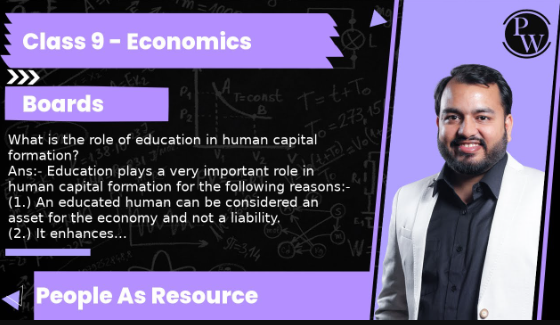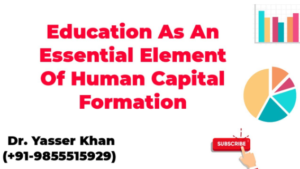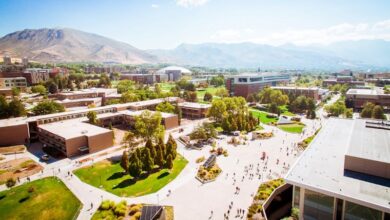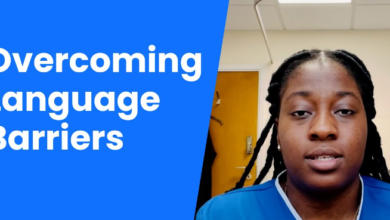What is the Role of Education in Human Capital Formation: Unveiling Keys to Growth

Education is pivotal for human capital formation as it enhances knowledge, skills, and abilities. It improves productivity and economic growth by fostering innovation and proficient labour.
Education lays the foundation for a society’s development, contributing significantly to human capital formation. A well-educated workforce is crucial for any nation’s competitiveness and ability to adapt to changing technological and economic conditions. Countries can equip individuals with the tools to drive innovation, entrepreneurship, and scientific advancement by investing in education.
This investment translates to a more skilled and adaptable labour force, bolstering economic stability and opening pathways to better job opportunities and higher wages. Consequently, the role of education extends beyond individual benefits, influencing the prosperity and advancement of entire communities and nations.
Contents
- 1 The Essence Of Education In Human Capital
- 2 Evolution Of Education’s Role
- 3 Components Of Human Capital Formation
- 4 Economic Implications Of Educated Populace
- 5 Case Studies: Success Stories Worldwide
- 6 Barriers To Educational Access
- 7 Future Trends In Education And Human Capital
- 8 Strategies For Strengthening Education’s Contribution
- 9 Measuring The Impact Of Education On Human Capital
- 10 Closing The Gap: Recommendations For Policymakers
- 11 Conclusion
The Essence Of Education In Human Capital

The Essence of Education in Human Capital underpins a country’s development. It moulds individuals into skilled workers. Schools and universities are the stages where potential transforms into expertise.
Fueling Economic Progress
Adequate education acts as the backbone of economic growth. Here’s why:
- Boosts Productivity: Workers gain skills to perform better.
- Spurs Innovation: Educated minds bring forth new ideas.
- Raises Earnings: Skilled people earn more, boosting demand and the economy.
- Attracts Investment: A skilled labour force draws companies to invest.
Enhancing Personal Development
Education’s impact goes beyond the economy. It shapes individuals. Here’s its role in personal growth:
- Builds Confidence: Knowledge makes people more confident.
- Encourages Critical Thinking: It teaches how to solve problems.
- Improves Social Skills: School is where people learn to collaborate.
- Ignites Lifelong Learning: Education instills a love for continuous learning.
Evolution Of Education’s Role
Education shapes minds and drives societies. Decades ago, it aimed to create disciplined individuals. Today, it’s about developing human capital, which includes skills, knowledge, and abilities. Each person’s human capital helps them contribute to their economy.
From Traditional To Knowledge Economies
The traditional model of education served past needs. It focused on reading, writing, and basic math, which were needed for most jobs. Farms and factories were the central workplaces.
Now, we live in the age of information. Knowledge is power in modern economies. Schools and universities teach critical thinking. They nurture problem-solving skills. These skills are vital in today’s workforce.
- Critical thinking fosters innovation.
- Problem-solving skills fuel tech advances.
- Collaboration prepares students for global teams.
Global Shifts In Educational Values
Educational values are changing worldwide. Societies value creativity over memorization. Students must now learn to adapt and handle complex problems.
Global education now focuses on:
- Lifelong learning for evolving job markets.
- Technology is used in every learning area.
- Interpersonal skills in diverse environments.
Today’s learners must be agile thinkers. They must communicate across cultures. The ultimate goal is to form adaptable, skilled citizens. This goal helps entire nations progress.
Components Of Human Capital Formation
Human capital formation is a crucial element of a country’s economic growth and individual prosperity. It involves enhancing people’s abilities so they can contribute effectively to society. Commonly, the formation harnesses various components, each pivotal in cultivating a skilled and adaptable workforce. Let’s delve into some essential components of human capital formation.
Academic Skills And Vocational Training
Academic skills are the bedrock of human capital. Primary, secondary, and tertiary education equip individuals with fundamental writing, reading, and arithmetic skills. Vocational training programs are vital to this knowledge base. They bridge the gap between education and the labour market, infusing practical skills that align with industry needs.
- Strengthen literacy and numeracy skills.
- Encourage problem-solving abilities
- Offer specialized training for various trades
- Equip students for immediate job entry
Critical Thinking And Creativity
Next in line is the development of critical thinking and creativity. These components empower individuals to analyze information, make informed decisions, and drive innovation. Education systems emphasizing these skills prepare students for unforeseen challenges and foster inventiveness, which is necessary in a rapidly changing world.
| Critical Thinking Skills | Creativity Skills |
| Logical analysis | Idea generation |
| Evaluation of arguments | Artistic expression |
| Decision-making processes | Innovative problem-solving |
Economic Implications Of Educated Populace
An educated populace serves as the backbone of a thriving economy. The role education plays in human capital formation is critical. Education fuels development across various economic sectors, expands skill sets, and leads to productive and innovative workforces. Nations with higher literacy rates often enjoy superior economic health. Let’s explore the dynamic impact of an educated population on the economy in a couple of key areas.
Productivity And Innovation
Education sparks productivity and innovation. Trained individuals utilize knowledge effectively. They enhance productivity levels in their work. This increase in output drives economic growth.
Key benefits include:
- Better problem-solving due to critical thinking skills
- Streamlined processes with creative approaches
- Adoption of the latest technologies
- Development of groundbreaking products
Attracting Foreign Investment
Investors seek out countries with skilled labour. An educated workforce entices foreign capital. This happens due to several factors:
| Factor | Impact |
| Skilled Labor | Increases operational efficiency |
| Innovation Capacity | It makes a region more competitive globally |
| Stable Economy | Promises a safer investment climate |
An educated population is magnetic to investment, fostering economic versatility and resilience.
Case Studies: Success Stories Worldwide
Educational progress proves vital in human capital formation. Nations rise by nurturing their youth. Insights from global success stories reveal this truth.
Asian Tigers: A Leap Forward
South Korea, Hong Kong, Singapore, and Taiwan are beacons of educational success. Known as the Asian Tigers, these countries have invested heavily in education.
- Enhanced literacy rates: Education policies have led to near-universal literacy.
- Skilled workforce: Focus on quality education created a highly skilled labour pool.
- Technological advancement: Schools emphasize science and technology, spurring innovation.
Education has turned these nations into economic powerhouses with remarkable growth rates.
Nordic Models: Sustainability And Welfare
Nordic countries like Sweden, Norway, and Finland value education. They blend it with welfare to form resilient human capital.
| Country | Education Success | Impact on Welfare |
| Sweden | Free university education | High standard of living |
| Norway | Investment in childhood learning | Strong social security system |
| Finland | Pioneering K-12 system | World-renowned social welfare |
Nordic nations showcase how education integrates with a robust welfare system for social sustainability.
Barriers To Educational Access
Education shapes the backbone of human capital formation. Yet, access to education presents multiple hurdles. Understanding these barriers can lead to solutions.
Socioeconomic Disparities
Income levels, family wealth, and parental education deeply affect education access. Families with lower incomes may need more resources essential for learning, such as books, technology, and a safe study environment.
- Costly school fees restrict entry for many children.
- The need to work to support family income can keep children out of school.
- Access to early education can ensure academic development is maintained.
These factors contribute to a divided education system where opportunities are unequal.
Institutional And Policy Challenges
Schools and governments sometimes erect additional barriers.
| Challenge | Impact |
| Underfunded Schools | Poor facilities and few teachers reduce quality. |
| Outdated Curricula | Students need to learn more relevant skills for today’s world. |
| Inadequate Policy | Without inclusion policies, marginalized groups suffer. |
Addressing these institutional and policy issues requires commitment and action at all government and society levels.
Future Trends In Education And Human Capital
Educational systems are evolving to create dynamic human capital for the future. The role they play in shaping individuals is critical. They must adapt to emerging trends and provide the skills needed for the future economy. Let’s explore trends set to revolutionize education and human capital.
Technology Integration
Technology in classrooms has moved beyond mere gadgets. It’s becoming an inseparable part of learning. Digital platforms enable interactive lessons. Artificial intelligence creates personalized learning experiences.
- Virtual Reality (VR) – Brings immersive learning experiences.
- Learning Management Systems – Connects students and teachers globally.
- Data Analytics – Tracks and improves student learning outcomes.
Lifelong Learning And Upskilling
The job market constantly changes. Lifelong learning ensures individuals remain employable. Upskilling is a must to stay competitive.
- Online Courses – Provide flexibility for learners to enhance their skills.
- Certification Programs – Help professionals stay relevant in their fields.
- Workshops and Webinars – Offer opportunities to gain new knowledge quickly.
Strategies For Strengthening Education’s Contribution
An effective education system is vital for human capital formation. It equips individuals with the skills, knowledge, and competencies necessary to thrive in the workforce. Strengthening education’s contribution to human capital requires strategic measures. It involves governments, private sectors, and international bodies working in tandem. Let’s explore strategies that can fortify the role of education in human capital development.
Government And Private Sector Roles
Both the government and private sectors have crucial roles in enhancing education. They create policies, fund programs, and build infrastructure to support learning. Governments can increase education budgets to improve public schools. The private sector can offer scholarships and invest in educational technology. Together, they ensure education remains relevant to current job markets and technologies.
- Government initiatives like subsidized tuition and improved curricula are key.
- Private sector partnerships can introduce innovative learning tools.
International Cooperation And Aid
Global partnerships and aid support education, especially in developing nations. International aid can fund school construction, teacher training, and learning materials. Cooperation brings global standards to local education systems. Sharing knowledge across borders can help align education with best practices worldwide.
- Aid programs: They can fund educational infrastructure and resources.
- Knowledge exchange: Partnerships introduce global teaching methods and materials.
Measuring The Impact Of Education On Human Capital
Education shapes our society by building human capital. It helps people to think, act and thrive. To understand how, we need tools. These tools check the value of education. They prove why learning is vital for growth.
Assessment Metrics
There are many ways to check what education gives us. We look at numbers like literacy rates and degrees earned. Testing skills also show how smart we are. With data, we see the power of learning. See the breakdown below:
- Literacy Rates: A clear sign of a region’s education level.
- Degrees and Certifications: These show how many experts we have.
- Skill Assessments: Tests that measure what we can do.
- Employment Rates: More jobs often mean better education.
- Income Levels: Higher earnings can link to better schooling.
Long-term Societal Benefits
Education’s actual value shows up over time. Good schools lead to intelligent people. Intelligent people make a prosperous society. With time, the gains are massive. Look below to see these effects:
- Health Improvements: Educated people live healthier and longer.
- Economic Growth: More knowledge leads to more money for all.
- Equality: Learning helps to make things fairer for everyone.
- Innovation: New ideas flourish where there is good education.
- Political Stability: With knowledge, people choose better leaders.
Closing The Gap: Recommendations For Policymakers
Educating a nation’s citizens is fundamental for human capital formation. Policymakers have the power to bridge educational disparities. By investing in education, they cultivate a skilled workforce, which drives innovation and economic growth. What steps can be taken to enhance educational outcomes? Let’s explore.
Investment In Education Infrastructure
Accessible, modern educational infrastructure is crucial. It lays the groundwork for effective learning. Government investment in schools and technology is needed. This ensures students can learn in a supportive environment.
- Building new schools in remote areas
- Upgrading facilities in existing schools
- Providing high-speed internet for digital learning
- Supplying modern educational tools and resources
Creating Inclusive Educational Systems
Every student deserves an equal chance at education. That means designing inclusive systems. These systems support learners from all backgrounds.
Inclusivity requires tailored approaches and policies. Here’s how to foster it:
- Develop programs for students with special needs
- Train teachers in inclusive education practices
- Promote gender equality in classrooms
- Assist marginalized communities with scholarships and grants
Conclusion
Education stands as a cornerstone of human capital development. It equips individuals with the skills necessary for productivity and innovation. Through learning, people gain competencies that drive economic growth and personal fulfilment. Nurturing minds through education lays the groundwork for a prosperous society.

